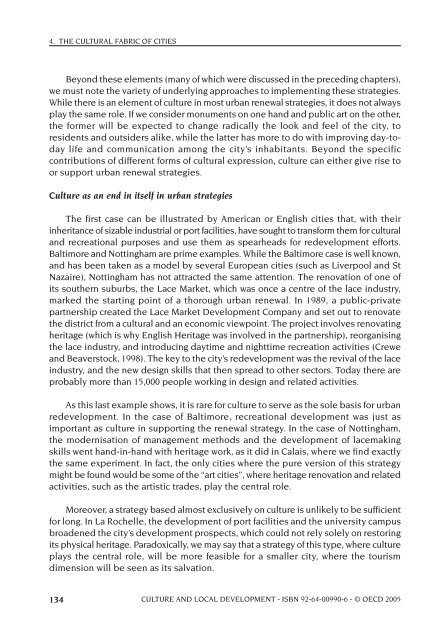OECD Culture and Local Development.pdf - PACA
OECD Culture and Local Development.pdf - PACA
OECD Culture and Local Development.pdf - PACA
You also want an ePaper? Increase the reach of your titles
YUMPU automatically turns print PDFs into web optimized ePapers that Google loves.
4. THE CULTURAL FABRIC OF CITIES<br />
Beyond these elements (many of which were discussed in the preceding chapters),<br />
we must note the variety of underlying approaches to implementing these strategies.<br />
While there is an element of culture in most urban renewal strategies, it does not always<br />
play the same role. If we consider monuments on one h<strong>and</strong> <strong>and</strong> public art on the other,<br />
the former will be expected to change radically the look <strong>and</strong> feel of the city, to<br />
residents <strong>and</strong> outsiders alike, while the latter has more to do with improving day-today<br />
life <strong>and</strong> communication among the city’s inhabitants. Beyond the specific<br />
contributions of different forms of cultural expression, culture can either give rise to<br />
or support urban renewal strategies.<br />
<strong>Culture</strong> as an end in itself in urban strategies<br />
The first case can be illustrated by American or English cities that, with their<br />
inheritance of sizable industrial or port facilities, have sought to transform them for cultural<br />
<strong>and</strong> recreational purposes <strong>and</strong> use them as spearheads for redevelopment efforts.<br />
Baltimore <strong>and</strong> Nottingham are prime examples. While the Baltimore case is well known,<br />
<strong>and</strong> has been taken as a model by several European cities (such as Liverpool <strong>and</strong> St<br />
Nazaire), Nottingham has not attracted the same attention. The renovation of one of<br />
its southern suburbs, the Lace Market, which was once a centre of the lace industry,<br />
marked the starting point of a thorough urban renewal. In 1989, a public-private<br />
partnership created the Lace Market <strong>Development</strong> Company <strong>and</strong> set out to renovate<br />
the district from a cultural <strong>and</strong> an economic viewpoint. The project involves renovating<br />
heritage (which is why English Heritage was involved in the partnership), reorganising<br />
the lace industry, <strong>and</strong> introducing daytime <strong>and</strong> nighttime recreation activities (Crewe<br />
<strong>and</strong> Beaverstock, 1998). The key to the city’s redevelopment was the revival of the lace<br />
industry, <strong>and</strong> the new design skills that then spread to other sectors. Today there are<br />
probably more than 15,000 people working in design <strong>and</strong> related activities.<br />
As this last example shows, it is rare for culture to serve as the sole basis for urban<br />
redevelopment. In the case of Baltimore, recreational development was just as<br />
important as culture in supporting the renewal strategy. In the case of Nottingham,<br />
the modernisation of management methods <strong>and</strong> the development of lacemaking<br />
skills went h<strong>and</strong>-in-h<strong>and</strong> with heritage work, as it did in Calais, where we find exactly<br />
the same experiment. In fact, the only cities where the pure version of this strategy<br />
might be found would be some of the “art cities”, where heritage renovation <strong>and</strong> related<br />
activities, such as the artistic trades, play the central role.<br />
Moreover, a strategy based almost exclusively on culture is unlikely to be sufficient<br />
for long. In La Rochelle, the development of port facilities <strong>and</strong> the university campus<br />
broadened the city’s development prospects, which could not rely solely on restoring<br />
its physical heritage. Paradoxically, we may say that a strategy of this type, where culture<br />
plays the central role, will be more feasible for a smaller city, where the tourism<br />
dimension will be seen as its salvation.<br />
134 CULTURE AND LOCAL DEVELOPMENT - ISBN 92-64-00990-6 - © <strong>OECD</strong> 2005














